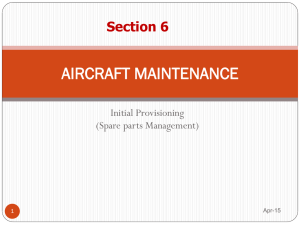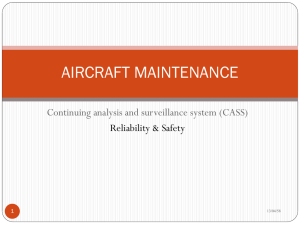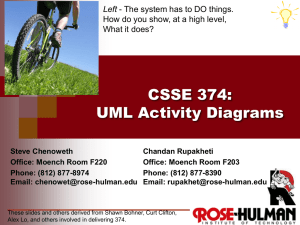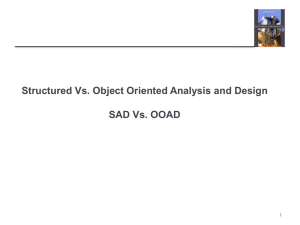Use Case
advertisement
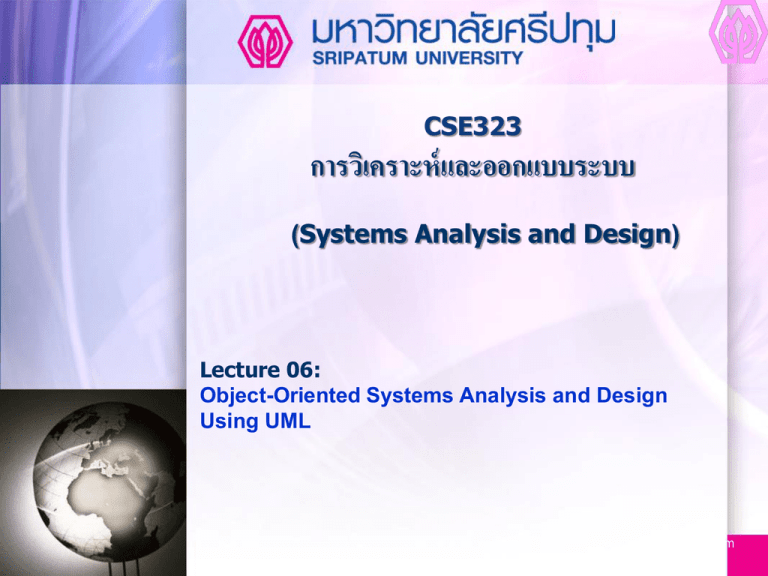
CSE323 การวิเคราะห์ และออกแบบระบบ (Systems Analysis and Design) Lecture 06: Object-Oriented Systems Analysis and Design Using UML www.themegallery.com Major Topics Apr-15 CSE323 Systems Object-oriented concepts and terminology CRC Cards Unified Modeling Language Use case and other UML diagrams Relationships 2 Object-Oriented Overview วิธกี ารเชงิ วัตถุ (Object-oriented techniques) ใช ้ ั ซอนได ้ ได ้ผลดีเมือ ่ ระบบทีม ่ ค ี วามซบ ้รับการบารุงรักษา ปรับปรุงเปลีย ่ นแปลง และออกแบบอย่างต่อเนือ ่ ง UML (The Unified Modeling Language) คือ มาตรฐาน (industry standard) สาหรับการจาลอง ระบบเชงิ วัตถุ Apr-15 CSE323 Systems 3 Goals of O-O Analysis เป้ าหมายของการวิเคราะห์เชงิ วัตถุ ้ การนากลับมาใชใหม่ คอ ื เป้ าหมายหลัก ระบบการบารุงรักษาเป็ นเป้ าหมายทีส่ าคัญ การเปลีย ่ นแปลงในออบเจ็กต์หนึง่ จะมีผลกระทบต่อ ออบเจ็กต์อน ื่ น ้อยทีส ่ ด ุ Apr-15 CSE323 Systems 4 Object-Oriented Concepts นิยามและแนวคิด: ออบเจ็กต์แทนสรรพสงิ่ ในโลกแห่งความเป็ นจริง (realworld thing) หรือเหตุการณ์ (event) ื้ ฯลฯ ออบเจ็กต์อาจเป็ น ลูกค ้า รายการ คาสงั่ ซอ ออบเจ็กต์อาจเป็ น GUI displays หรือ text areas on a display ออบเจ็กต์ถก ู แทนด ้วยคลาสและจัดป็ นกลุม ่ ของคลาส ั คลาสหรือกลุม ่ ของคลาสมีคณ ุ สมบัตแ ิ ละบริการหรือฟั งก์ชน การทางานร่วมกัน ้ อ • Instantiate เป็ นคาทีใ่ ชเมื ่ มีการสร ้างออบเจ็กต์ขน ึ้ จากคลาส • Attributes หรือแอททริบวิ ท์ คือลักษณะประจาหรือคุณสมบัตข ิ อง คลาสทีท ่ ก ุ ออบเจ็กต์ในคลาสนัน ้ มี ้ ้ • Method หรือเมทธอด คืองานอย่างใดอย่างหนึง่ ทีส ่ ามารถเรียกใชได จากออบเจ็กต์ในคลาส Apr-15 CSE323 Systems 5 Class Symbol ั ลักษณ์ของคลาส สญ Apr-15 CSE323 Systems 6 Inheritance ื ทอดคุณสมบัต ิ การสบ ื ทอดคุณสมบัต ิ (Inheritance) เกิดขึน การสบ ้ เมือ ่ มีการ สร ้างคลาสขึน ้ ใหม่จากคลาสทีม ่ อ ี ยูแ ่ ล ้ว คลาสเดิมจะเป็ นคลาสแม่ (parent or base class) คลาสใหม่จะเป็ นคลาสลูก (child or derived class) คลาสลูกได ้รับการถ่ายทอดคุณสมบัตแิ ละบริการหรือ ั การทางานจากตลาสแม่ ฟั งก์ชน Apr-15 CSE323 Systems 7 CRC Cards การ์ด CRC (Class, responsibilities, and collaborators) ั พันธ์ ใชส้ าหรับแสดงความรับผิดชอบของคลาสและปฏิสม ระหว่างคลาส การสร ้างการ์ด CRC หาคานามและคากริยาในประโยคปั ญหา สร ้างสถานการณ์จาลอง (Scenarios) โดยพิจารณาจากการทางานตาม จริงของระบบ ิ้ เล็กลงและเล็กลงเรือ ระบุและกาหนดความรับผิดชอบให ้กับงานชน ่ ยๆ เท่าทีจ ่ ะทาได ้ พิจาณาว่างานต่างๆทาได ้โดยออบเจ็กต์หรือการโต ้ตอบกับออบเจ็ กต์ อืน ่ ไอย่างไร ั การทางาน ระบุความรับผิดชอบทีเ่ กีย ่ วข ้องเป็ นเมทธอดหรือฟั งก์ชน Apr-15 CSE323 Systems 8 The Unified Modeling Language (UML) UML has three categories: สงิ่ ต่างๆ หรือ ออบเจ็กต์ (Things, the objects) ั พันธ์ (Relationships, the glue that holds things ความสม together) แผนภาพ (Diagrams, categorized as either structure or behavioral) Apr-15 CSE323 Systems 9 Two General Groupings of Things กลุม ่ ของสง่ ต่างๆใน UML: Structural things ซงึ่ ใชก้ าหนดโครงสร ้างตามแนวคิดและ โครงสร ้างทางกายภาพของระบบเชงิ วัตถุ และอธิบายด ้วย คานาม Behavioral things เป็ นคากริยาในแบบจาลอง UML ทีใ่ ช ้ แทนพฤติกรรมของระบบ และสถานะของระบบ ก่อน ระหว่าง และหลัง เมือ ่ มีพฤติกรรมดังกล่าวเกิดขึน ้ Apr-15 CSE323 Systems 10 Structural and Behavioral Things Structural things ได ้แก่: Classes. Use cases. Interfaces. Behavioral things ได ้แก่: Interactions State machines Apr-15 CSE323 Systems 11 Types of Relationships ั พันธ์: ประเภทของความสม Structural relationships ผูกสงิ่ ต่างๆเข ้าด ้วกันในแผนภาพ โครงสร ้าง (Structural diagram) ้ Behavioral relationship ใชในแผนภาพเหตุ การณ์ (Behavioral diagrams) Apr-15 CSE323 Systems 12 Structural and Behavioral Relationships Structural relationships ได ้แก่: Dependencies. Aggregations. Associations. Generalizations. Behavioral relationships ได ้แก่: Apr-15 CSE323 Systems Communicates. Includes. Extends. Generalizes. 13 Structural and Behavioral Diagrams Structural things are the most common and include: Class and object diagrams. Use case diagrams. Component diagrams. Deployment diagrams. Behavioral things include: Apr-15 CSE323 Systems Use case diagrams. Sequence diagrams. Collaboration diagrams. Statechart diagrams. Activity diagrams. 14 Commonly Used UML Diagrams แผนภาพทีใ่ ชกั้ นโดยทั่วไปใน UML: แผนภาพยูสเคส (Use case diagram) อธิบายว่าระบบถูกใช ้ อย่างไร • เป็ นจุดเริม ่ ต ้นสาหรับแบบจาลอง UML ยูสเคส (Use case - not a diagram) แผนภาพกิจกรรม (Activity diagram) • แต่ละยูสเคสอาจสร ้างแผนภาพกิจกรรม แผนภาพลาดับเหตุการณ์ (Sequence diagram) แสดง ั พันธ์ชอง ลาดับเหตุการณ์ของกิจกรรมต่างๆและความสม คลาส • แต่ละยูสเคสอาจสร ้างหนึง่ หรือหลายแผนภาพลาดับเหตุการณ์ • A collaboration diagram is an alternative to a sequence diagram. Apr-15 CSE323 Systems 15 Commonly Used UML Diagrams แผนภาพทีใ่ ชกั้ นโดยทั่วไปใน UML (ต่อ): แผนภาพคลาส (Class diagram) แสดงคลาสต่างๆและ ั พันธ์ของคลาส ความสม • แผนภาพลาดับเหตุการณ์ (Sequence diagrams) และการ์ด CRC ้ ใชในการก าหนดคลาส แผนภาพสถานะ (Statechart diagram) • แต่ละคลาสสามารถสร ้างแผนภาพสถานะ ซงึ่ มีประโยชน์ในการ กาหนดเมทธอดของคลาส Apr-15 CSE323 Systems 16 Overview of UML Diagrams Apr-15 CSE323 Systems 17 Use Case Diagram A use case describes what the system does, not how it does the work. The use case model reflects the view of the system of the user outside of the system. Symbols are: Actor, a stick figure. Use case, an oval. Connecting lines. Apr-15 CSE323 Systems 18 Actors Represent role played by one or more users Exist outside of the system May be a person, another system, a device, such as a keyboard or Web connection Can initiate an instance of a use case May interact with one or more use cases and a use case may involve one or more actors Apr-15 CSE323 Systems 19 Actors (Cont.) Actors may be divided into two groups: Primary actors supply data or receive information from the system Secondary actors help to keep the system running or provide help • Help desk, analysts, programmers, etc. Apr-15 CSE323 Systems 20 Use Case Consists of three things: An actor (user) that initiates an event. An event that triggers a use case. The use case that performs the actions triggered by the event. Apr-15 CSE323 Systems 21 Use Case (Cont.) Better to create fewer use cases 20 use cases for a large system 50 use cases would be the maximum for a large system Can nest use cases, if needed Apr-15 CSE323 Systems 22 Use Case Relationships Communicates Connect an actor to a use case Includes Use case contains a behavior that is common to more than one use case. The common use case is included in other use cases. Dotted arrow points toward common use case. Apr-15 CSE323 Systems 23 Use Case Relationships (Continued) Extends A different use case handles variations or exceptions from the basic use case. Arrow goes from extended to basic use case. Generalizes One thing is more general than another thing. Arrow points to the general thing. Apr-15 CSE323 Systems 24 Use Case Relationships Apr-15 CSE323 Systems Analysis and Design 2/2549 25 Steps for Creating a Use Case Model The steps required to create a use case model are: Review the business specifications and identify the actors within the problem domain. Identify the high-level events and develop the primary use cases that describe the events and how actors initiate them. Review each primary use case to determine possible variations of flow through the use case. Develop the use case documents for all primary use cases and all important use case scenarios. Apr-15 CSE323 Systems Analysis and Design 2/2549 26 Use Case Scenario A use case scenario may be created for the standard flow through the use case. Other scenarios may be created for variations on the main flow. A use case includes: Use case identifiers and initiators. Steps performed. Conditions, assumptions, and questions. Apr-15 CSE323 Systems 27 Activity Diagrams Activity diagrams show the sequence of activities in a process, including sequential and parallel activities. Symbols are used for activities, decisions and so on. Arrows represent events that connect the activities. Apr-15 CSE323 Systems 28 Activity Diagram Symbols Apr-15 CSE323 Systems 29 Creating Activity Diagrams Ask what happens first, second, and so on. Determine if the activities happen in sequence or parallel. Examine all the scenarios for a use case. Apr-15 CSE323 Systems 30 Swimlanes Included on activity diagrams to show partitioning Show which activities: Occur on a browser Occur on a server Happen on a mainframe Are done by external partners Help to divide tasks among team members Apr-15 CSE323 Systems 31 Swimlane Boundaries When an event crosses swimlane boundaries, data must be transmitted. A Web form is sent to a server. Data are placed into middleware to transmit it between a server and a mainframe. Data are transmitted to and from an external partner. Apr-15 CSE323 Systems 32 Sequence Diagrams Sequence diagrams show a succession of interactions between classes or object instances over time. It also shows the processing described in a single scenario. The leftmost object is the starting object. Time sequence is from top to bottom. Apr-15 CSE323 Systems 33 Sequence Diagrams (Cont.) Horizontal arrows represent messages or signals sent between classes. Solid arrowheads represent synchronous calls, the sending class waits for a response. Half or open arrowheads represent asynchronous calls, those sent without waiting for a returning signal. Apr-15 CSE323 Systems 34 Message Name Formats Message names may be in the following formats: messageName() messageName(parameter1, parameter2, …) messageName(parameterType:parameterName)(defaultValue) Apr-15 CSE323 Systems 35 Sequence Diagram Example Apr-15 CSE323 Systems 36 Collaboration Diagrams Collaboration Diagrams show the same information as a sequence diagram. The emphasis is on the organization of the objects. Sequence is shown by including a sequence number on the message. Apr-15 CSE323 Systems 37 Collaboration Diagram Example Apr-15 CSE323 Systems 38 Class Diagrams and Class Attributes Class diagrams show classes, attributes, and operations or methods. A class is shown as a rectangle. Attributes are either: Private (the norm), indicated by a minus sign. Public, indicated by a plus sign. Protected, indicated by a pound sign (#). Attributes may include the type of data and any initial value. Methods are usually public. Apr-15 CSE323 Systems 39 Method Overloading Method overloading is including the same method several times in a class. The method signature, its name and parameters, and type of parameters, must be different. Apr-15 CSE323 Systems 40 Types of Classes Classes fall into several categories: Entity classes. Boundary or interface classes. Abstract classes. Control classes. Each class may use a special symbol, called a UML stereotype. Apr-15 CSE323 Systems 41 Entity Classes Entity classes represent real-world items. Attributes are those stored for the entity. Methods work with the entity. Apr-15 CSE323 Systems 42 Boundary or Interface Classes Provide a means for users to work with the system. Display screens, windows, dialogue boxes, touch-tone telephone, external systems. Methods required to send or reset the display screen, or to produce a report. Apr-15 CSE323 Systems 43 Abstract Classes Abstract classes are the parent or general class in a generalization/specialization relationship. Abstract classes may not be directly instantiated. Only the child classes can create objects. Apr-15 CSE323 Systems 44 Control or Active Classes Control or active classes are used to control the flow of activities. Many small control classes may be included to achieve reuse. Attributes are those needed temporarily by the control class. Methods are those used in control activities . Apr-15 CSE323 Systems 45 Sequence Diagram for using two Web pages: one for student information, one for course information. Apr-15 CSE323 Systems 46 Relationships on a Class Diagram Relationships are the connections between classes and include: Associations, showing the one-to-many relationships between classes. • An asterisk (*) is used to represent many. Association classes are used to break up a many-tomany association between classes. Apr-15 CSE323 Systems 47 Association Class Example Apr-15 CSE323 Systems 48 Whole/Part Relationships One class represents the whole, other classes represent the parts contained in the whole. Three types of whole/part relationships: Aggregation. Collection. Composition. Apr-15 CSE323 Systems 49 Aggregation Apr-15 CSE323 Systems Aggregation is a “has a” relationship. The whole is composed of the sum of the parts. If the whole is removed, the part may still exist. The diamond at the end of the line is not filled in. 50 Collection Consists of a whole and its members Examples are a library with books or a voting district with voters If the part is removed, the whole retains its identity A weak association Apr-15 CSE323 Systems 51 Composition The whole has a responsibility for the parts, and is a stronger relationship. If the whole is removed, the parts are removed Shown with a filled-in diamond on the line Example: an insurance policy with riders Apr-15 CSE323 Systems 52 Whole/Part Example Apr-15 CSE323 Systems 53 Generalization/Specialization Diagrams Generalization/specialization or gen/spec diagrams Apr-15 CSE323 Systems show the relationship between a more general thing and a specific kind of thing. This relationship is described as an “is a” relationship. For example: a car is a vehicle, a truck is a vehicle. Generalization relationship is used to model inheritance. General class is a parent, base, or superclass. Specialized class is a child, derived, or subclass. 54 Polymorphism Polymorphism or method overriding is when a method is defined in several classes in a gen/spec relationship. The subclass overrides the parent class attributes and/or methods. If a number of classes are involved, the most specific class is used. Apr-15 CSE323 Systems 55 Gen/Spec Example Apr-15 CSE323 Systems 56 Finding Classes Classes may be discovered: During interviews or JAD sessions. During brainstorming sessions. By using CRC cards. By examining use cases, looking for nouns. • Each noun may lead to a candidate or potential class. Apr-15 CSE323 Systems 57 Determining Class Methods Class methods may be determined by: Using a CRUD matrix. Looking at messages sent between classes. • The receiving class must have the message name as a method. Using statechart diagrams. Apr-15 CSE323 Systems 58 Statechart Diagrams Statechart diagrams show class states and the events that cause them to transition between states. It is also called a state transition diagram An event happens at a specific time and place. They cause a change of state, or the transition “fires” Apr-15 CSE323 Systems 59 Statechart Diagrams (Cont.) Each time an object changes state, some of its attributes must change. There must be a method to change the attributes. Often there is a display screen or Web form to enter the attributes. Apr-15 CSE323 Systems 60 Statechart Diagrams (Cont.) Statechart diagrams are not created for all classes. They are created when: A class has a complex life cycle. An instance of a class may update its attributes in a number of ways through the life cycle. A class has an operational life cycle. Two classes depend on each other. The object’s current behavior depends on what happened previously. Apr-15 CSE323 Systems 61 Statechart Example Apr-15 CSE323 Systems 62 Packages Containers for other UML things Show system partitioning Indicate which use cases or classes are grouped into a subsystem Can show component packages Can be physical subsystems Use a folder symbol Apr-15 CSE323 Systems 63 Package Example Apr-15 CSE323 Systems 64 Steps Used in UML The steps used in UML are: Define the use case model. Continue UML diagramming to model the system. during the systems analysis phase. Develop the class diagrams. Draw statechart diagrams. Begin systems design by refining the UML diagrams. Document your system design in detail. Apr-15 CSE323 Systems 65 Next Lecture Object Interaction and Specifying Operations Apr-15 CSE323 Systems 66


